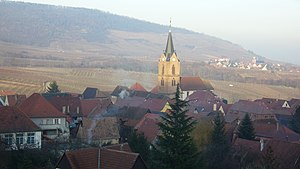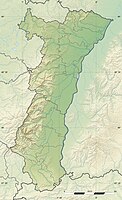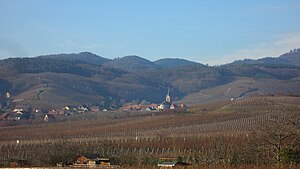 | ||
| Rodern | ||
| region | Grand Est | |
|---|---|---|
| Residents | 371 (2018) | |
| height | 260 m | |
| Tourist info | 33 (0)3 89 73 23 23 http://www.ribeauville-riquewihr.com | |
| no tourist info on Wikidata: | ||
| location | ||
| ||
Rodern is a small winemaking village in FrenchAlsace and member of the association of Pays de Ribeauvillé and Riquewihr. Rodern is in the 3rd section of the Alsatian wine route (Terre et Vins au Pays de Colmar). The village is in the immediate vicinity too Saint-Hippolyte, with which it is also the vineyard Alsace Grand Cru Gloeckelberg Splits.
Rodern is one Ville fleurie, a "flower-adorned city" and carries im Concours des villes et villages fleuris ("Competition of cities and towns decorated with flowers") 2 out of 4 roses.
background
Something about the story
Presumably on the site of today's church there was a fortified settlement before 1000 AD to protect the nearby border between Upper and Lower Alsace. Even back then, viticulture was the most important branch of the economy. The lower-lying local area is surrounded by vineyards, while the higher up to the Taennchef massif (988 m) is forested. The most famous location is Alsace Gran Cru Gloeckelberg, but the place is also known for Pinot Noir vines. Most of the houses date from the 16th to 18th centuries, have a cellar and a brick ground floor on which a half-timbered building is built. Only rich citizens could afford a house made entirely of stone. One of these buildings, called "Schloessel", is in the lower part of the village.
The crest
.svg/200px-Blason_de_la_ville_de_Rodern_(68).svg.png)
Blazon: (Source: Book of arms of the municipalities in Haut-Rhin from 1981)
- D'or à la roue de voitue de sable à six rais, deux rais formant un diamètre vertical.
getting there
By plane
The nearest commercial airports are the Strasbourg airport![]() (IATA: SXB) , 55 km and EuroAirport Basel-Mulhouse-Freiburg
(IATA: SXB) , 55 km and EuroAirport Basel-Mulhouse-Freiburg![]() (IATA: BSL, MLH, EAP), 82 km.
(IATA: BSL, MLH, EAP), 82 km.
The Colmar-Houssen airfield (17 km away) allows the landing of small private planes.
By train
The place does not have a train station. The nearest train station with a TGV stop is in Colmar.
By bus
A 109 bus connects Colmar every 4 hours. There is no bus connection to Sélestat, you have to go to Colmar and then take the train there.
In the street
The journey takes place by car
- from north and south over the
 Alsacienne auto route,
Alsacienne auto route,  18 Saint-Hippolyte, then about that D 1bis and the D 6 directly in the center of the village.
18 Saint-Hippolyte, then about that D 1bis and the D 6 directly in the center of the village. - from the west from inland (Sainte-Croix-aux-Mines) about the N 59 to Lièpvre and D 481 to the department border, then on the one that is now called D 42 and the D 1bis to Saint-Hippolyte, from there to the roundabout to the D 6 and on this directly in the place.
- from the east: The next Rhine crossings to Germany are at Breisach (41 km) and Marckolsheim (25 km)
mobility

Like many others in the region, the place is surrounded by vineyards. The location is sloping slightly to the southeast. At about 300 m, the main road drops by 27 m. This is also the route on which most of the described sights are located Rue du Pinot Noir.
Tourist Attractions

A possible stroll through the place can be at the confluence of the Rue du Silberberg in the Rue du Pinot Noir start:
- 1 - On the entrance gate of house number 22 in the Rue du Pinot Noir you can see the initials "HW" and "CM". They represent the owner Hans Weber and his wife Caroline Michel. Weber was the first elected mayor of the village in 1802. The house itself was mentioned as early as 1408.
- 2 - 28 rue du Pinot Noir: A typical winegrower's house at the beginning of the 18th century. Built in 1735. The guild mark of the winemakers can be seen under the bay window.
- 3 - 31 rue du Pinot Noir: The house bears the coat of arms of Bergheim and the year the house was built, 1541. Mayor François-Joseph Weber lived here, who did a great job for the village.
- 4 - Town hall: A parish hall has stood here since the beginning of the 14th century as the seat of the administration and the community jurisdiction, as well as an inn. It was rebuilt in 1713 and extensively rebuilt around 1830, the result of which can be seen today.
- 5 - The first Gothic church was built on a hill in the village on the site of today's St. George's Church in 1310, of which the ground floor of the church tower is still preserved, which today forms the base of the current church tower. In 1750 the church was rebuilt and larger and in the Baroque style of the era of Louis XVI. fitted. Visiting the interior is possible after collecting the key from the town hall.
- 6 - On the half-timbering of the corner house Rue du Pinot Noir / Rue de l'Église you can see that it originally consisted of two houses. It has two beautiful cellar entrances with the year of construction 1562 and 1676 engraved as well as the owner's sign and the cooper's guild sign.
- 7 - 41 rue du Pinot Noir: This house was rebuilt in 2001 after a fire. It dates from 1560. Some structural elements were reused: The bay console with the number 1589 with the guild signs of the winemaker and the farmer, the framing of the gateway with the year 1541 with stylized flowers and the Bergheim coat of arms.
- 8 - 43 rue du Pinot Noir: Here you can see the year of construction 1541 and the guild mark of the cooper.
- 9 - This house on the corner of the Rue du Pinot Noir and the Place de la Fontaine was proven as early as 1408 and was called that at that time Frühmess Hüssbecause the owner gave the church money to finance the early mass. This almost unchanged house also bears the cooper's mark.
- 10 - The fountain on the Place de la Fontaine has been proven since the 15th century; it was the main source of water in the place.
- 11 - Lock: The date 1616, the initials and an individual owner's mark on the cellar door lintel prove that the house was rebuilt by Lorentz Walter. From 1726 the building belonged to the Strasbourg Jesuits, from 1740 to the dean of the Alsatian Supreme Court (Conseil Souverain d'Alsace), Lawyer Kieffer, who made it the "Schlösschen" that can still be admired today. It later passed into the possession of his son-in-law, François de Boug, who was then 1st President of the aforementioned court. The family remained the owners of the property until 1823.
- 12 - 10 rue des Seigneurs: At the beginning of the 16th century there were two houses here, which were soon combined into one large winegrower's house with a forecourt and a spacious garden behind the house. Georges de Boug, son of the President of the Court (see Lock) and vicar general of the diocese of Basel and later Strasbourg, enlarged the house in 1805 and left it with a half-hip roof (Croupette) that it still owns today.
- 13 - End of Impasse de la Forge ("Dead end of the blacksmiths"): The beautiful half-timbered house was rebuilt in 1692 after the destruction of the Thirty Years' War.
- 14 - 6-8 rue de Thannenkirch: These beautiful houses date from the beginning of the 18th century.
- 15 - Place des Charpentiers ("Zimmermannsplatz"): In former times whole tree trunks were processed into timber by sawmills and carpenters. Between 1790 and 1810 the space became too small for it and was built on. Today there is a public toilet here.
- 16 - 5-7 rue du Gloeckelberg: To note are the Wheel deflectors in the entrance gate and the year 1797 in the lintel.
activities
- During a walk to the Schaenzelkopf (710 m), about 4 km away, on very good vineyard trails, you will roam the terroir of the Grand Cru Gloeckelberg and always have a magnificent view of Rodern, Saint-Hippolyte and the Haut-Koenigsbourg castle ruins. The path leads partly on the old road, along the border between Lower and Upper Alsace.
- There are other, numerous hiking trails, especially in the Taennchel massif, e.g. to the Carrefour de la Lach (You leave the place at the end of the Rue des Seigneurs and follow the signs).
shop
There is little or no shopping opportunity for everyday goods, everything is available in the larger neighboring towns, in Ribeauvillé, Colmar or Sélestat.
kitchen
There are many Winstubswhich offer small, regional dishes in addition to wine. Restaurants can be found in some of the neighboring communities.
nightlife
accommodation
- 1 Le Schaentzel - Danielle Hestin, 9 la Cave de Rodern, 68590 Rodern. Tel.: 33 (0)3 89 73 04 79, Email: [email protected]. Simple holiday apartment, non-smoker, no animals, bed & breakfast.
- 2 Hotel Schloessel, 7 Rue des Seigneurs, 68590 Rodern. Tel.: 33 (0)3 89 73 00 18, Email: [email protected]. Building from 1667. Geö. from April to December, rooms from 50 euros.
- 3 Gîte au calme Rodern, 14 rue des Seigneurs, 68590 Rodern. Tel.: 33 (0)3 89 73 09 03. Simple vacation rental, weekly rental.
- 4 Pêche de Vigne, Lucie Goetschy, 31 rue du Pinot Noir, 68590 Rodern. Tel.: 33 (0)3 69 06 49 04. Attractive hotel with several rooms from 120 euros, restoration only by appointment.
- 5 Gîte Rodern, 1 rue du Gloeckelberg, Rodern. Simple, clean apartment.
security
health
Emergency numbers
Please refer Emergency numbers in France
Practical advice
trips
The place is an ideal starting point in the other very beautiful villages of the community association, in the Vosges, to the nearby castle ruins Haut-Koenigsbourg and to Colmar.
literature
Individual references and sources
- Tourist information brochure (also in German)
Web links
- An official website is not known.






